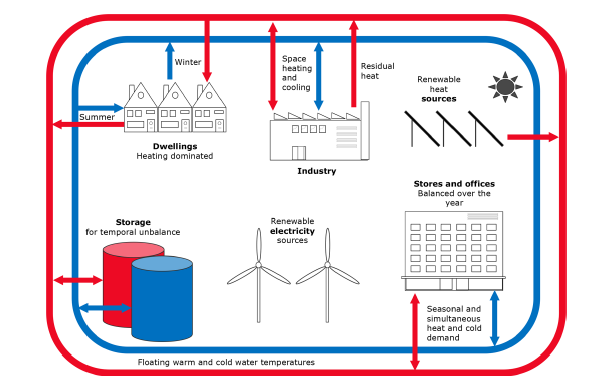
By Design Tech Solutions — Delivering Next-Generation Heat Network Design
Introduction: A New Generation of Heat Networks
Heat networks are evolving fast. From high-temperature legacy systems to smart, decentralised solutions, the industry has reached its fifth generation — and it’s transforming how we deliver low-carbon heat in the UK.
5th generation heat networks (5GHN) operate at ambient temperature and use decentralised energy inputs and local heat pumps at the point of use. They offer better efficiency, lower carbon, and more flexibility — especially for new developments or mixed-use schemes.
At DTS, we design 5G-ready systems that are future-proof, resilient, and fully aligned with net zero goals.
What Defines a 5th Generation Heat Network?
Ambient Temperature Operation
The network operates close to ground temperature (10–30°C), reducing heat losses and improving pump efficiency.
Bidirectional Energy Flows
Buildings can act as both heat users and sources — recovering waste heat from cooling systems or processes.
Local Heat Pump Use
Each building or dwelling uses a heat pump to raise temperature as needed — enabling tailored demand.
Decentralised Layout
No centralised boiler or CHP — energy input is distributed and renewable-focused.
Smart Control Integration
Sensors and automation adjust flow and usage in real time to maximise efficiency.
Benefits of 5G Heat Networks
Ultra Low-Carbon
Reduced operational losses and full compatibility with low-carbon inputs.
Flexible & Scalable
Networks can grow in stages and adapt to future zoning, density, or retrofit needs.
Smart-Ready by Default
Digital control platforms, metering, and analytics are integral to design.
Heat Recovery Potential
Captures and redistributes heat from cooling, ventilation, or industrial processes.
Ideal for Dense Urban or Mixed-Use Sites
Works well in areas with balanced heating and cooling loads or shared infrastructure.
How DTS Supports 5G Network Design
Ambient Loop Modelling
We simulate flow, temperature, and pipe sizing for efficiency and thermal stability.
Heat Pump Integration Strategy
We advise on unit types, plant space, and zoning logic for building-level performance.
Material & Layout Specification
We design pipework, trenching, and insulation for ambient conditions and bidirectional flow.
Digital Twin Development
We deliver models that simulate performance, optimise layout, and support monitoring and reporting.
FAQ
When to Consider 5G Network Design
New residential or mixed-use schemes
Brownfield redevelopments
Urban infill projects with cooling/heating load overlap
Where decentralisation or building-level energy ownership is preferred
Projects seeking alignment with Net Zero Carbon standards, LETI, or PSDS/HNIP funding
Let’s Design the Next Generation
If you're exploring low-temperature, smart-ready, future-proof systems, 5G heat networks are the next step — and DTS can help you lead the way.
RELATED READS
Explore our detailed guides on designing effective, future-ready district heating systems. Each article is written to help clients, developers, and stakeholders understand what great network design looks like in practice.







